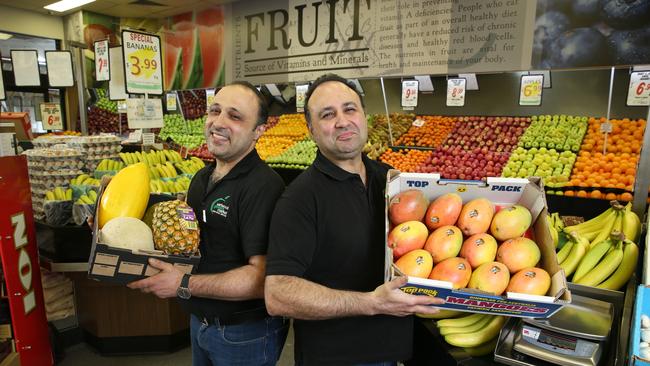Market forces put squeeze on farmers
Farmers paying scarce workers higher wages while skyrocketing freight costs make it too expensive to export produce overseas.

Farmers say they are being squeezed after being forced to pay scarce workers higher wages while skyrocketing freight costs make it too expensive to export their produce overseas.
But the higher price of casual farm labour — in some cases $500 a day, double the usual rate — and uncertainty over international borders has some producers wary of planting crops, with the lack of future supply expected to send the price of some fruits and vegetables up to 29 per cent higher.
For now, however, local produce is cheaper than it has been for some years. Melbourne Wholesale Markets data shows lettuce and brown onion prices are 20 per cent lower than they were in January 2019. Tomato prices have fallen by 50 per cent, while royal gala apple prices are flat, the figures show.

Aryan Norozi, a retail analyst at investment bank UBS, says the wetter weather in the past few months will likely result in larger crops — and even lower prices in the short term. “We expect modest inflation (vs pre-COVID) in dry goods and inflation in red meat, while we expect deflation in fruit and vegetables,” he said.
The pandemic has left the fruit-picking industry scrambling to fill 26,000 jobs. Dasha Sherif, a farmer in Shepparton, Victoria, who largely grows apricots, said in previous harvests he had paid workers $45 a box. Now they were charging $80. “We are getting dictated to by workers and are having to pay whatever they want us to pay,” Mr Sherif said. “And this is being made worse by the export market being so expensive. We are so saturated here on the market it’s just a bloodbath.”
The fall in wholesale prices has been made worse for farmers by a surge in export costs, in particular the airfreight relied on by summer fruits such as cherries and avocados. Craig Woolford, head of research at investment bank Citi, said freight costs had doubled in the past three months. “The container freight rate cost is usually not a large cost so an increase in these rates does have an impact,” he said.
Despite the federal government’s export subsidy program — known as the International Freight Assistance Mechanism — shipping $1.2bn in fresh fruit and vegetables since the start of the pandemic, sales to several major trading partners have declined significantly.
The most recent export figures, for the year ending December, show exports fell 6.3 per cent in value and 6.6 per cent in quantity, with the largest falls recorded in sales to Thailand (down 29.4 per cent in value), Japan (down 25.8 per cent), and South Korea (down 20.3 per cent).
The IFAM was on Thursday extended until the end of September, a move described as “nothing short of a critical lifeline for agricultural commodities” by National Farmers Federation chief executive Tony Mahar.
Joe Forese, who owns the Earlwood Growers Market in Sydney’s southwest with his brother Pasquale, said prices for fruit and vegetables were some of the cheapest he’d seen.
“This year all the produce that couldn’t be exported remained locally,” he said. “We haven’t got enough population to eat all the fruit. There’s so much fruit on the market right now. Grapes, nectarines, peaches, plums, figs, it’s all much cheaper than usual. At the end of the day, the growers need to sell.”
Cherries, which should have sold at up to $45 a kilo in January and February were being sold for $30, he said, while stone fruit which usually retails at about $4.99 a kilo was selling for $2.99.
The Australian Bureau of Agricultural and Resource Economics and Sciences, however, is predicting smaller crops will end up costing consumers significantly more. With a lack of overseas harvest workers, the agency forecasts fruit production to drop as much as 17 per cent and vegetable production by about 2 per cent, pushing prices up by between 7 and 29 per cent.
Australian Fresh Produce Alliance chief executive Michael Rogers said he was concerned the current oversupply of fruit and vegetables could lead to food shortages down the track.
“With weaker consumer demand, no international tourism, and lower migration, prices have been pushed down,” he said. “But we are concerned the underlying factor of workforce supply and oversupply on the market now could mean growers stop planting. We may end up having shortages.”
The lack of overseas workers has pushed the National Agriculture Labour Advisory Committee to recommend giving up to 100,000 undocumented farm workers the green light to stay in the country, as well as making it simpler for workers to move on and off dole payments. The strategy is also aimed at cracking down on employers exploiting backpackers and migrant workers, including threatening a five-year ban on employing overseas workers if they are found to have broken workplace or migration laws.







To join the conversation, please log in. Don't have an account? Register
Join the conversation, you are commenting as Logout